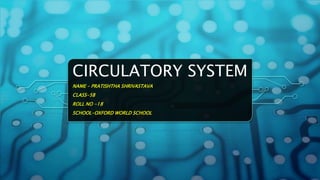
Small Presentation on Circulatory system for class 5
- 1. CIRCULATORY SYSTEM NAME – PRATISHTHA SHRIVASTAVA CLASS-5B ROLL NO -18 SCHOOL-OXFORD WORLD SCHOOL
- 2. TABLE OF CONTENTS • Human Circulatory System • Features • Organs of Circulatory System 1.Heart 2.Blood Vessels 3.Blood
- 3. HUMAN CIRCULATORY SYSTEM • The human body is a complex machine, requiring many processes to function efficiently. To keep these crucial processes running without any hitches, vital elements and components need to be delivered to the various parts of the body. • This role of transportation is undertaken by the human circulatory system, moving essential nutrients and minerals throughout the body and metabolic waste products away from the body.
- 4. FEATURES OF CIRCULATORY SYSTEM • The human circulatory system consists of blood, heart, blood vessels. • It circulates blood through two loops (double circulation) – One for oxygenated blood, another for deoxygenated blood. • It consists of four chambers – two ventricles and two auricles. • It possesses a body-wide network of blood vessels. These comprise arteries, veins, and capillaries. • The primary function of blood vessels is to transport oxygenated blood and nutrients to all parts of the body. • Most circulatory system diagrams do not visually represent its sheer length. Theoretically, if the veins, arteries, and capillaries of a human were laid out, end to end, it would span a total distance of 1,00,000 kilometers (or roughly eight times the diameter of the Earth).
- 5. ORGANS OF CIRCULATORY SYSTEM • HEART • The heart is a muscular organ that acts as the pump of the circulatory system. • It has four chambers: two atria (upper chambers) and two ventricles (lower chambers). • The right side of the heart receives deoxygenated blood from the body and pumps it to the lungs for oxygenation. The left side receives oxygenated blood from the lungs and pumps it to the rest of the body. • BLOOD VESSELS • Arteries: Carry oxygenated blood away from the heart to various parts of the body. The largest artery is the aorta. • Veins: Transport deoxygenated blood from the body back to the heart. The superior and inferior vena cava are the largest veins. • Capillaries: Tiny, thin-walled vessels that connect arteries and veins, allowing for the exchange of nutrients, oxygen, and waste products with tissues.
- 6. ORGANS OF CIRCULATORY SYSTEM • BLOOD • Blood is a fluid connective tissue that circulates throughout the circulatory system. • Plasma: The liquid component of blood that carries water, nutrients, hormones, and waste products. • Red Blood Cells (Erythrocytes): Contain hemoglobin and transport oxygen from the lungs to the rest of the body. • White Blood Cells (Leukocytes): Play a crucial role in the immune system, defending the body against infections. • Platelets: Fragments of cells involved in blood clotting and wound healing.